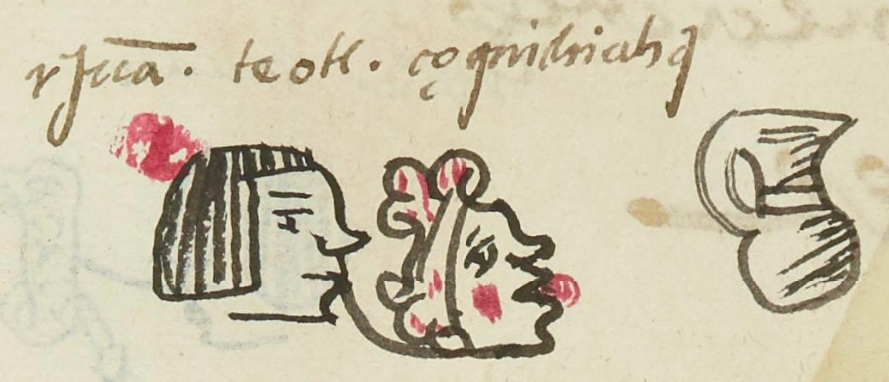Teotl (MH576r)
This black-line drawing of the compound glyph for the personal name Teotl (“Deity” pr "Spirit," attested here as a man’s name) shows an anthropomorphic head in profile, facing toward the viewer's right. Some red colorant has been added to the area in front of the mouth, the cheek, and the curling bits that seem to suggest a stone (tetl), a phonetic indicator for the start of the word teotl. The "stone" even has a diagonal stripe, which further suggests that stone is meant for this phonetic purpose (not contributing any semantic meaning).
Stephanie Wood
Glyphs for teotl in the Codex Mendoza (c. 1541) do not have faces; they are half-suns. But by 1560, in the Matrícula de Huexotzinco, Christian influences seem to have led to the use of faces on some teotl glyphs, such as this one. See comparisons, below. This glyph here is much like the glyph for Teotl on MH575v, but that one leaves out the red colorant.
Stephanie Wood
juā. teotl.
Juan Teotl
Stephanie Wood
1560
Jeff Haskett-Wood
deities, deidades, faces, caras, stones, rocks, piedras

teo(tl), divine force, divinity, deity, https://nahuatl.wired-humanities.org/content/teotl
La Deidad, La Fuerza Divina
Stephanie Wood
Matrícula de Huexotzinco, folio 576r, https://www.loc.gov/resource/gdcwdl.wdl_15282/?sp=231&st=image
This manuscript is hosted by the Library of Congress and the World Digital Library; used here with the Creative Commons, “Attribution-NonCommercial-ShareAlike 3.0 License” (CC-BY-NC-SAq 3.0).






